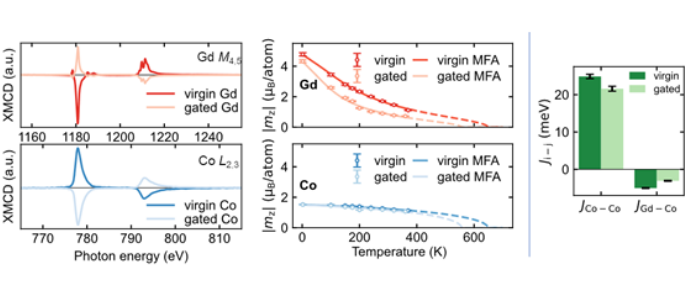Cerdanyola del Vallès, 30 July 2021.The rapid increase of data generated nowadays requires denser data storage and more efficient data processing. Controlling the magnetic state of a material by electrical means enables spin-based data storage and data manipulation. One key technological challenge is to achieve 180° magnetic switching efficiently by electrical means, which has the potential to dramatically reduce the global power consumption of data storage.
Ferrimagnets present unique opportunities for achieving 180° switching because of a multi-sublattice configuration with sublattice magnetizations of different magnitudes opposing each other. In the study, researchers showed that the dominant sublattice of GdCo ferrimagnetic film can be reversibly toggled by hydrogen loading/unloading using a solid-state hydrogen pump structure as shown in Figure 1, where a proton-conducting solid-state electrolyte is placed between two electrodes. By applying a gate voltage across the structure, the moisture from the ambient can be dissociated at the top electrode to form protons and oxygen gas. The protons are driven to the bottom electrode and get loaded into the bottom electrode (GdCo). Figure 1 shows that the hydrogen loading switched the dominant sublattice at room temperature, and the hydrogen loading induced a > 100K drop in the compensation temperature of GdCo.

Figure 1: Voltage control of the dominant sublattice and compensation of GdCo. (top) Schematic illustration of the device structure. (bottom) Coercivity of GdCo versus temperature before and after gate voltage application. The temperature where coercivity diverges corresponds to the compensation temperature, which is reduced by > 100K after applying a gate voltage.
To study the mechanism of the observed compensation temperature change induced by voltage gating, element-specific XMCD spectroscopy was carried out at the BL29-BOREAS end station for devices before and after voltage-induced hydrogen loading into GdCo. As shown in Figure 2, high-quality XMCD spectra were collected for both the Gd and Co elements. Measurements were carried out at different temperatures and the sublattice magnetizations were calculated using the sum rules. The results reveal that hydrogenation substantially reduces the sublattice magnetization of Gd, but only modestly reduces that of Co at finite temperatures. Using mean-field approximation modeling, the study further shows that the effect of the hydrogen loading into GdCo involves a reduction of the strength of the antiferromagnetic coupling between the Gd and Co sublattices.

Figure 2: (left) Exemplary XMCD spectra collected at BL29-BOREAS end station and extracted sublattice magnetization as a function of temperature before and after gate voltage application. MFA: mean-field approximation. (right) Extracted exchange coupling strengths from MFA modeling showing that voltage gating induces a large fractional decrease of the intersublattice coupling strength.
Using appropriately-designed heterostructures, the study demonstrated gate voltage induced external-field-free deterministic 180° reversal of either the sublattice magnetizations or the net magnetization. Figure 3 shows the 180° switching of sublattice magnetizations, where the integration of a hard nanomagnet into the device provides a bias stray field that is enough to fix the direction of the net magnetization, so that the sublattice magnetizations are flipped by 180° when the dominance sublattice is switched.

Figure 3: (left) Device structure for external-field-free 180° switching of the sublattice magnetizations. (right) Anomalous Hall effect hysteresis loops of GdCo showing switched sublattice magnetizations with voltage gating.
In addition to 180° magnetic reversals, the study also covered the switching speed (< 50us), and cyclability (> 10,000 cycles without degradation) of the mechanism. In addition, because the gating effect is localized under the gate region, it also allows for the generation of spin textures such as reversed domains and skyrmion bubbles on a racetrack device. The mechanism may also apply to a wide range of rare-earth transition-metal ferrimagnets for tuning a wide range of properties and phenomena such as spin dynamics and spin texture characteristics and may find application in data storage and neuromorphic computing.
Reference: Mantao Huang, Muhammad Usama Hasan, Konstantin Klyukin, Delin Zhang, Deyuan Lyu, Pierluigi Gargiani, Manuel Valvidares, Sara Sheffels, Alexandra Churikova, Felix Büttner, Jonas Zehner, Lucas Caretta, Ki-Young Lee, Joonyeon Chang, Jian-Ping Wang, Karin Leistner, Bilge Yildiz and Geoffrey S. D. Beach. Voltage control of ferrimagnetic order and voltage-assisted writing of ferrimagnetic spin textures. Nature Nanotechnology (2021). DOI: https://doi.org/10.1038/s41565-021-00940-1




